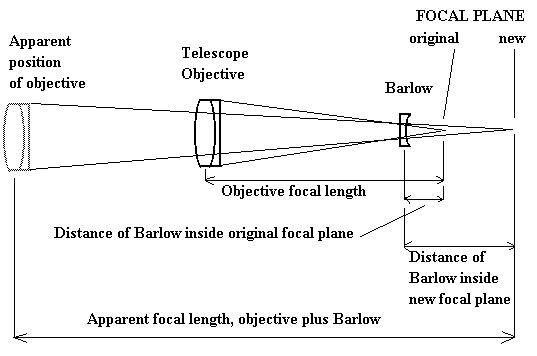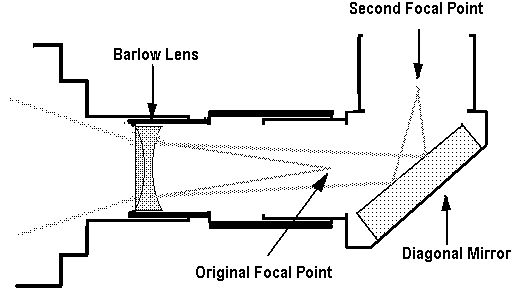Multiply Your Eyepieces with a Barlow Lens
Jack Kramer
Want to expand your collection of eyepieces as painlessly as possible? A Barlow lens is the answer. (It's also known as a "telenegative amplifier".) This type of optic appeared about forty-five years ago as a single cell-mounted plano-concave lens that doubled or tripled the power of an eyepiece. Today's versions use two or three lenses to make it achromatic. A Barlow extends the cone of light to multiply the power of an eyepiece by a certain factor, most frequently two or three times. The amplifying power depends on the separation between the Barlow and the eyepiece focal point. The new Tele Vue Powermate is the penultimate Barlow: it boosts the magnification by a whopping 5x! Barlows effectively increase the apparent focal length of the telescope objective, thus "fooling" the eyepiece into thinking it's working in a telescope with a larger focal ratio. And the longer the focal length, the greater the magnification with any given eyepiece. For example, an eyepiece that provides 50x by itself will provide 100x when coupled with a 2x Barlow. Here's how it works:

Actually, some of the sophisticated, wide-field eyepiece designs incorporate a type of Barlow lens into the barrel to help achieve their results. Assuming you have a good longer focal length eyepiece to begin with, it often makes sense to employ a Barlow to increase your magnification, rather than spend even more money for an additional eyepiece. But there was a drawback to the old simple Barlow lenses. They sometimes degraded the sharpness and brightness of the image by introducing that extra optical element. The latest versions avoid degradation by using high-transmission lens coatings, plus an additional element or two to improve the correction of the system. Moreover, they maintain the more comfortable eye relief of the longer focal length eyepieces with which they're used. According to Terence Dickinson, the prolific writer on astronomical observing, "A modern Barlow will not degrade your telescope's optics. Anyone telling you otherwise is using outdated information."
Nonetheless, if you use one of the new Barlows with an ultra-wide-field eyepiece that employs anywhere up to eight optical elements, your total eyepiece system may now have as many as eleven elements. I suspect that so many lenses would just have to prove somewhat detrimental to light transmission. In fact, a Tele Vue catalog didn't mention using Barlows in conjunction with Naglers - only with their Plossl oculars.
Most telescopes can use any of the Barlow lenses on the market. However, the position of the focal plane on some scopes precludes using certain Barlows with particular eyepieces. The Russian-made Maksutov-Cassegrains and Maksutov-Newtonians seem to fall in this category. (These telescopes are also a bit picky about which eyepieces they will accept.)
A Barlow offers the best performance at a single optimal position in the lens system. This means that a fixed Barlow lens (which presumably is optimized) is preferable to a variable power Barlow. As a matter of fact, all the Barlow lenses currently on the market are non-adjustable and provide a certain stated amplification factor. But a review of Barlow lenses in Sky & Telescope magazine a couple of years ago noted that the stated amplification is often an approximation. One example is the Meade 2x "shorty" Barlow, which really gives an amplification factor of 1.76x. There is a way to measure and calculate the true amplification, but my eyes glaze over when faced with math formulas ... and I've never really concerned myself with the exact magnification anyway. The one stated advantage of the old adjustable Barlows was that they allowed the user to move the lens in its cell for the best position with each different eyepiece. If you have an adjustable Barlow, it's wise to experiment to locate the ideal position for the lenses.
Despite the specs for a given Barlow, there is actually a way to get more than one amplification factor out of a single, non-adjustable Barlow lens. This depends on the design of the telescope you're using. If your telescope is a Schmidt-Cassegrain, refractor, or other design that uses a right-angle adapter, or star diagonal, then mounting the Barlow in front of the diagonal will amplify the power by an additional factor. For example, a Barlow that increases the magnification by 2x when mounted directly in front of the eyepiece will provide about 3x when mounted in front of the star diagonal instead. The following diagram shows roughly how this works. As the Barlow is placed farther inside the focal plane of the telescope, the eyepiece in the star diagonal ends up farther from the Barlow lens, increasing the amplification factor. The eyepiece is thus "fooled" again into thinking that it's being used in a telescope with an even longer focal length than before.

Since a Barlow lens costs less than a good eyepiece, you sly rascal, you have effectively doubled (and maybe even tripled) the number of your eyepieces without spending a whole lot of money!
Published in the March 2000 issue of the NightTimes




